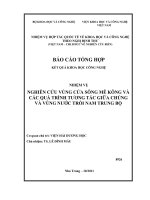Tương tác giữa PHP và jQuery - part 11 potx
Bạn đang xem bản rút gọn của tài liệu. Xem và tải ngay bản đầy đủ của tài liệu tại đây (403.37 KB, 10 trang )
CHAPTER 3 ■ OBJECT-ORIENTED PROGRAMMING
101
return $this->getProperty();
}
public function setProperty($newval)
{
$this->prop1 = $newval;
}
public function getProperty()
{
return $this->prop1 . "<br />";
}
}
class MyOtherClass extends MyClass
{
public function __construct()
{
echo "A new constructor in " . __CLASS__ . ".<br />";
}
public function newMethod()
{
echo "From a new method in " . __CLASS__ . ".<br />";
}
}
// Create a new object
$newobj = new MyOtherClass;
// Output the object as a string
echo $newobj->newMethod();
// Use a method from the parent class
echo $newobj->getProperty();
?>
This changes the output in the browser to:
A new constructor in MyOtherClass.
From a new method in MyOtherClass.
I'm a class property!
The class "MyClass" was destroyed.
CHAPTER 3 ■ OBJECT-ORIENTED PROGRAMMING
102
Preserving Original Method Functionality While Overwriting Methods
To add new functionality to an inherited method while keeping the original method intact, use the
parent keyword with the scope resolution operator (::):
<?php
class MyClass
{
public $prop1 = "I'm a class property!";
public function __construct()
{
echo 'The class "', __CLASS__, '" was initiated!<br />';
}
public function __destruct()
{
echo 'The class "', __CLASS__, '" was destroyed.<br />';
}
public function __toString()
{
echo "Using the toString method: ";
return $this->getProperty();
}
public function setProperty($newval)
{
$this->prop1 = $newval;
}
public function getProperty()
{
return $this->prop1 . "<br />";
}
}
class MyOtherClass extends MyClass
{
public function __construct()
{
parent::__construct(); // Call the parent class's constructor
echo "A new constructor in " . __CLASS__ . ".<br />";
}
public function newMethod()
{
echo "From a new method in " . __CLASS__ . ".<br />";
}
}
CHAPTER 3 ■ OBJECT-ORIENTED PROGRAMMING
103
// Create a new object
$newobj = new MyOtherClass;
// Output the object as a string
echo $newobj->newMethod();
// Use a method from the parent class
echo $newobj->getProperty();
?>
This outputs the result of both the parent constructor and the new class’s constructor:
The class "MyClass" was initiated!
A new constructor in MyOtherClass.
From a new method in MyOtherClass.
I'm a class property!
The class "MyClass" was destroyed.
Assigning the Visibility of Properties and Methods
For added control over objects, methods and properties are assigned visibility. This controls how and
from where properties and methods can be accessed. There are three visibility keywords: public,
protected, and private. In addition to its visibility, a method or property can be declared as static,
which allows them to be accessed without an instantiation of the class.
■ Note Visibility is a new feature as of PHP 5. For information on OOP compatibility with PHP 4, see the PHP
manual page at
Public Properties and Methods
All the methods and properties you’ve used so far have been public. This means that they can be
accessed anywhere, both within the class and externally.
CHAPTER 3 ■ OBJECT-ORIENTED PROGRAMMING
104
Protected Properties and Methods
When a property or method is declared protected, it can only be accessed within the class itself or in
descendant classes (classes that extend the class containing the protected method).
Declare the getProperty() method as protected in MyClass and try to access it directly from outside
the class:
<?php
class MyClass
{
public $prop1 = "I'm a class property!";
public function __construct()
{
echo 'The class "', __CLASS__, '" was initiated!<br />';
}
public function __destruct()
{
echo 'The class "', __CLASS__, '" was destroyed.<br />';
}
public function __toString()
{
echo "Using the toString method: ";
return $this->getProperty();
}
public function setProperty($newval)
{
$this->prop1 = $newval;
}
protected function getProperty()
{
return $this->prop1 . "<br />";
}
}
class MyOtherClass extends MyClass
{
public function __construct()
{
parent::__construct();
echo "A new constructor in " . __CLASS__ . ".<br />";
}
public function newMethod()
{
echo "From a new method in " . __CLASS__ . ".<br />";
CHAPTER 3 ■ OBJECT-ORIENTED PROGRAMMING
105
}
}
// Create a new object
$newobj = new MyOtherClass;
// Attempt to call a protected method
echo $newobj->getProperty();
?>
Upon attempting to run this script, the following error shows up:
The class "MyClass" was initiated!
A new constructor in MyOtherClass.
Fatal error: Call to protected method MyClass::getProperty() from context '' in
/Applications/XAMPP/xamppfiles/htdocs/testing/test.php on line 55
Now, create a new method in MyOtherClass to call the getProperty() method:
<?php
class MyClass
{
public $prop1 = "I'm a class property!";
public function __construct()
{
echo 'The class "', __CLASS__, '" was initiated!<br />';
}
public function __destruct()
{
echo 'The class "', __CLASS__, '" was destroyed.<br />';
}
public function __toString()
{
echo "Using the toString method: ";
return $this->getProperty();
}
public function setProperty($newval)
{
CHAPTER 3 ■ OBJECT-ORIENTED PROGRAMMING
106
$this->prop1 = $newval;
}
protected function getProperty()
{
return $this->prop1 . "<br />";
}
}
class MyOtherClass extends MyClass
{
public function __construct()
{
parent::__construct();
echo "A new constructor in " . __CLASS__ . ".<br />";
}
public function newMethod()
{
echo "From a new method in " . __CLASS__ . ".<br />";
}
public function callProtected()
{
return $this->getProperty();
}
}
// Create a new object
$newobj = new MyOtherClass;
// Call the protected method from within a public method
echo $newobj->callProtected();
?>
This generates the desired result:
The class "MyClass" was initiated!
A new constructor in MyOtherClass.
I'm a class property!
The class "MyClass" was destroyed.
CHAPTER 3 ■ OBJECT-ORIENTED PROGRAMMING
107
Private Properties and Methods
A property or method declared private is accessible only from within the class that defines it. This
means that even if a new class extends the class that defines a private property, that property or method
will not be available at all within the child class.
To demonstrate this, declare getProperty() as private in MyClass, and attempt to call
callProtected() from MyOtherClass:
<?php
class MyClass
{
public $prop1 = "I'm a class property!";
public function __construct()
{
echo 'The class "', __CLASS__, '" was initiated!<br />';
}
public function __destruct()
{
echo 'The class "', __CLASS__, '" was destroyed.<br />';
}
public function __toString()
{
echo "Using the toString method: ";
return $this->getProperty();
}
public function setProperty($newval)
{
$this->prop1 = $newval;
}
private function getProperty()
{
return $this->prop1 . "<br />";
}
}
class MyOtherClass extends MyClass
{
public function __construct()
{
parent::__construct();
echo "A new constructor in " . __CLASS__ . ".<br />";
}
public function newMethod()
{
CHAPTER 3 ■ OBJECT-ORIENTED PROGRAMMING
108
echo "From a new method in " . __CLASS__ . ".<br />";
}
public function callProtected()
{
return $this->getProperty();
}
}
// Create a new object
$newobj = new MyOtherClass;
// Use a method from the parent class
echo $newobj->callProtected();
?>
Reload your browser, and the following error appears:
The class "MyClass" was initiated!
A new constructor in MyOtherClass.
Fatal error: Call to private method MyClass::getProperty() from context 'MyOtherClass' in
/Applications/XAMPP/xamppfiles/htdocs/testing/test.php on line 49
Static Properties and Methods
A method or property declared static can be accessed without first instantiating the class; you simply
supply the class name, scope resolution operator, and the property or method name.
One of the major benefits to using static properties is that they keep their stored values for the
duration of the script. This means that if you modify a static property and access it later in the script, the
modified value will still be stored.
To demonstrate this, add a static property called $count and a static method called plusOne() to
MyClass. Then set up a do while loop to output the incremented value of $count as long as the value is
less than 10:
<?php
class MyClass
{
public $prop1 = "I'm a class property!";
public static $count = 0;
CHAPTER 3 ■ OBJECT-ORIENTED PROGRAMMING
109
public function __construct()
{
echo 'The class "', __CLASS__, '" was initiated!<br />';
}
public function __destruct()
{
echo 'The class "', __CLASS__, '" was destroyed.<br />';
}
public function __toString()
{
echo "Using the toString method: ";
return $this->getProperty();
}
public function setProperty($newval)
{
$this->prop1 = $newval;
}
private function getProperty()
{
return $this->prop1 . "<br />";
}
public static function plusOne()
{
return "The count is " . ++self::$count . ".<br />";
}
}
class MyOtherClass extends MyClass
{
public function __construct()
{
parent::__construct();
echo "A new constructor in " . __CLASS__ . ".<br />";
}
public function newMethod()
{
echo "From a new method in " . __CLASS__ . ".<br />";
}
public function callProtected()
{
return $this->getProperty();
}
}
CHAPTER 3 ■ OBJECT-ORIENTED PROGRAMMING
110
do
{
// Call plusOne without instantiating MyClass
echo MyClass::plusOne();
} while ( MyClass::$count < 10 );
?>
■ Note When accessing static properties, the dollar sign ($) comes after the scope resolution operator.
When you load this script in your browser, the following is output:
The count is 1.
The count is 2.
The count is 3.
The count is 4.
The count is 5.
The count is 6.
The count is 7.
The count is 8.
The count is 9.
The count is 10.
Commenting with DocBlocks
While not an official part of OOP, the DocBlock commenting style is a widely accepted method of
documenting classes. Aside from providing a standard for developers to use when writing code, it has
also been adopted by many of the most popular SDKs (software development kits (SDKs), such as
Eclipse (available at ) and NetBeans (available at ), and will be
used to generate code hints.
A DocBlock is defined by using a block comment that starts with an additional asterisk:
/**
* This is a very basic DocBlock









